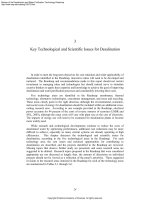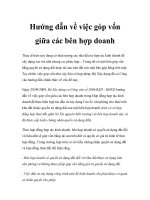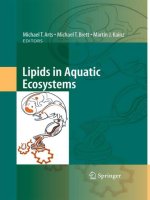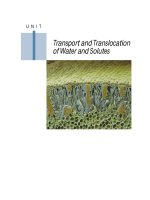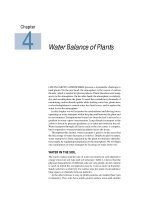Fresh water Ben thic Ecosystems docx
Bạn đang xem bản rút gọn của tài liệu. Xem và tải ngay bản đầy đủ của tài liệu tại đây (45.59 MB, 781 trang )
Alga,1 Ecology
Freshwater Benthic Ecosystems
AQUATIC ECOLOGY Series
Series Editor
James H. Thorp
Department of Biology
University of Louisville
Louisville, Kentucky
Other titles in the series:
Groundwater Ecology
Janine Gibert, Dan L. Danielopol, Jack A. Stanford
Fresh water Ben thic Ecosystems
Edited by
R. Jan Stevenson
Department of Biology
University of Louisville
Louisville, Kentucky
Max L. Both well
Environmental Sciences
National Hydrological Research Institute
Saskatoon, Saskatchewan, Canada
Rex L. Lowe
Department of Biological Sciences
Bowling Green State University
Bowling Green, Ohio
ACADEMIC PRESS
San Diego New York Boston London Sydney Tokyo Toronto
Front cover photograph:
The filamentous diatom
Aulacoseira
entangled among the stalked diatoms
Cymbella and Gomphonema.
(See Chapter 1, Figure 1 for more details.)
This book is printed on acid-flee paper. (~
Copyright 1996, Elsevier (USA)
All rights reserved.
No part of this publication may be reproduced or transmitted in any form or by any
means, electronic or mechanical, including photocopy, recording, or any information
storage and retrieval system, without permission in writing from the publisher.
Requests for permission to make copies of any part of the work should be mailed to:
Permissions Department, Harcourt, Inc., 6277 Sea Harbor Drive, Orlando, Florida 32887-6777.
Academic Press
An imprint of Elsevier
525 B Street, Suite 1900, San Diego, California 92101-4495, USA
Academic Press
84 Theobald's Road, London WC1X 8RR, UK
http ://www. academicpress, com
Library of Congress Cataloging-in-Publication Data
Algal ecology: freshwater benthic ecosystems/edited by R. Jan
Stevenson, Max I. Bothwell, Rex L. Lowe.
p. cm (Aquatic ecology series)
Includes bibliographical references and index.
ISBN 0-12-668450-2 (alk. paper)
1. Freshwater algae Ecology. 2. Freshwater ecology.
I. Stevenson, R. Jan. II. Bothwell, M.L. (Max L.) III. Lowe, Rex
IV. Series.
QK570.25.A43 1996
589.3'5 dc20 95-51737
CIP
PRINTED IN THE UNITED STATES OF AMERICA
03 04 05 06 9 8 7 6 5 4
Jan and Rex graciously asked me to dedicate this book to my
wife Carol R. Bothwell (deceased November 5, 1994) in
remembrance of the selfless dedication she gave to me over
the years so that my career might prosper. In this, she was
not unlike many other wives, including Mariellyn Stevenson
and Sheryn Lowe, who spend their lives nurturing their
husbands and children so that they might grow and fulfill their
own dreams.
Max L. Bothwell
This Page Intentionally Left Blank
Contents
Contributors xxi
Preface xxiii
Acknowledgments
XXV
SECTION
ONE
PATTERNS OF BENTHIC ALGAE IN
AQUATIC ECOSYSTEMS
1 An Introduction to Algal Ecology in Freshwater
Benthic Habitats
R. Jan Stevenson
vii
viii
Contents
I. The Diversity of Benthic Algae and Their Habitats
in Fresh Waters 3
A. The Taxonomic and Morphological Diversity of
Benthic Algae 3
B. The Habitats of Freshwater Benthic Algae 8
II. The Niche of Freshwater Benthic Algae 10
A. The Role of Benthic Algae in Ecosystems 10
B. How Are Algae in Benthos and
Plankton Different? 11
III. Methods for Characterizing Freshwater
Benthic Algae 12
A. Population and Community Structure 12
B. Population and Community Function 18
W. Conceptual Frameworks for Benthic Algal
Community Ecology 23
References 26
2 Patterns in Benthic Algae of Streams
Barry J. E Biggs
I. Introduction 31
A. Conceptual Overview: Disturbance-Resource
Supply-Grazer Control of Stream
Benthic Algae 32
B. Typical Biomass Values for Streams 34
II. Temporal Patterns 36
A. Short Term 36
B. LongTerm 38
III. Spatial Patterns 42
A. Microscale: Substratum Patterns 42
B. Mesoscale- Within Catchment Patterns 43
C. Broadscale: Intercatchment Patterns 44
IV. Benthic Algal Proliferations 46
V. Concluding Remarks 51
References 51
3
Periphyton Patterns in Lakes
Rex L. Lowe
I. Introduction 57
II. The Lentic Periphyton Community
A. Habitat 58
B. TheBiota
59
58
Contents ix
4
III. Important Influential Factors 63
A. Overview 63
13. Resources 64
C. Disturbance 68
IV. Conclusions and Missing Pieces 71
References 72
Pattern in Wetlands
L. Gordon Goldsborough and Gordon G. C. Robinson
I. Introduction 78
II. Algal Assemblages in Wetlands 78
III. The Role of Algae in Wetlands 81
IV. Species Composition of Wetland Algae 87
V. Algal Production in Wetlands 89
VI. Factors Affecting Algal Production 90
A. Hydrodynamics 90
B. Nutrients 91
C. Light 94
D. Temperature 96
E. Macrophytes 97
E Herbivory and Other Faunal Influences
G. Anthropogenic Factors 101
VII. Conceptual Model of Wetland Algae 103
A. Dry State 103
B. Open State 105
C. Sheltered State 107
D. Lake State 108
VIII. Conclusion 109
References 109
99
SECTION
5
TWO
FACTORS AFFECTING BENTHIC ALGAE
Effects of Light
Walter R. Hill
I. Introduction 121
II. Photosynthetic Processes
122
x Contents
6
III. Benthic Light Environments 123
A. Terrestrial Vegetation 124
B. Attenuation by the Water Column
C. Matrix Effects 125
IV. Photosynthesis-Irradiance Relations
A. Exposure Diversity 128
B. Shade Adaptation 129
C. Photoinhibition 131
D. Saturation 133
E. Compensation Point 134
F. Estimating
in Situ
Primary Production
V. Ecological Effects of Light Intensity 135
A. Biomass and Productivity 135
B. Taxonomic Responses 138
VI. Ecological Effects of Light Quality 141
VII. Ultraviolet Radiation 142
VIII. Summary 143
References 144
125
127
134
Periphyton Responses to Temperature at
Different Ecological Levels
Dean M. DeNicola
I. Introduction 150
A. Temporal and Spatial Variation of Temperature
in Benthic Habitats 150
B. Examination of Periphyton Responses
to Temperature 152
II. Autecological Responses 153
A. Photosynthesis and Respiration 154
B. Cell Composition 156
C. Heat Shock Proteins 157
D. Life Cycles 157
III. Population Responses 158
A. Temperature and Maximum
Growth Rates 158
B. Temperature Tolerance Ranges and Optima
for Growth 159
C. Interactive Effects of Temperature and Nutrient
Limitation on Growth Rates 162
IV. Community Structure 163
A. Lotic Periphyton 163
B. Lentic Periphyton 166
Contents
xi
V.
Ecosystem Response 169
A.
Lotic Periphyton Biomass and
Primary Production 169
B.
Lentic Periphyton Biomass and
Primary Production 172
VI.
Global Temperature Changes 173
VII. Synthesis 174
References 176
7
Nutrients
Mark
A.
Borchardt
I.
Introduction 184
II. Conceptual Framework: Nutrient Uptake and
Growth Kinetics 186
A.
Empirical Models 186
B.
Concept of Threshold Nutrient Limitation and
Optimum Nutrient Ratio 189
C.
Differential Limitation
of
Growth Rate
and Biomass 189
D. Temperature and Light Interactions 190
E.
Steady-State versus Non-Steady-
State Growth 191
III. Conceptual Framework:
Microhydrodynamic Environment 193
A.
Boundary Layer and Sublayer 193
B.
Molecular and Eddy Diffusion 194
C. Diffusion Limitation 195
D. Boundary Layer Instability 196
IV.
Nutrient Limitation of Benthic Algae 196
A.
Patterns 196
B.
Growth-Limiting Concentrations and Ratios
of
Nand
P
197
C. Overriding Effects of Light, Disturbance,
and Grazing 206
D. Nutrients and Species Composition
207
V.
Nutrient Kinetics
of
Benthic Algae 208
VI. Effects
of
Water Motion
on
Benthic Algal Nutrient
Uptake and Nutrient-Limited Growth 212
A.
Positive Effects
of
Water Motion 212
B.
Negative Effects
of
Water Motion 213
C. Interaction of Flow Velocity and
Nutrient Concentration 214
xii
Contents
VII. Nutrient Competition 214
A. Characterizing Nutrient
Competitive Ability 214
B. Predicting Competition with
Optimum Ratios 216
C. Effects of Water Motion on
Nutrient Competition 217
D. Nutrient Competition among
Benthic Algae 218
References 218
8
Resource Competition and Species Coexistence
in Freshwater Benthic Algal Assemblages
Paul V. McCormick
I. Introductory Remarks 229
II. Basic Theory and Predictions: The Lotka-Volterra
Equations and the Competitive
Exclusion Principle 232
III. Limitations to Classical Theory: Equilibrium and
Nonequilibrium Coexistence in
Competitive Hierarchies 235
IV. Adaptive Traits Conferring Competitive Dominance
and Avoidance 238
A. Traits Conferring Competitive Dominance 239
B. Tolerance to Stress 242
C. Disturbance-Adapted Species 244
D. Are Trade-offs Absolute? 245
V. Summary and Recommendations for
Future Research 247
References 249
9
Interactions of Benthic Algae with
Their Substrata
JoAnn M. Burkholder
I. Introduction: The Interface Niche of
Benthic Algae 253
II. Substratum Physical Influences 258
III. The Challenge of Examining Substratum
Chemical Influences 261
Contents
xiii
IV. Known Influences of Substratum Composition 263
A. Rock Substrata and Epilithic/
Endolithic Algae 263
B. The Edaphic Habit: Epipsammic and Epipelic
Algae among Sands and Other Sediments 264
C. Plant Substrata and Epiphytic Algae 267
D. Animal Substrata and Epizoic Algae 275
E. Advanced Chemical Interdependence:
Algal Endosymbiosis 277
V. Conclusions and Recommendations 286
References 289
10
The Role of Heterotrophy in Algae
Nancy C. Tuchman
I. Defining Autotrophy and Heterotrophy 299
A. Illustrations and Evidence of Facultative
Heterotrophy in Algae 303
B. Discerning the Difference between
Heterotrophic and Dormant Algae 306
C. Mechanisms of Organic Substrate Uptake and
Relative Efficiency of Heterotrophic Metabolism
in Algae 308
II. The Ecological Roles of Algal Heterotrophy in
Benthic Assemblages 311
A. Development of a Resource Gradient within a
Periphyton Mat and Implications for Cells atthe
Base of the Mat 312
B. The Role of Algal Heterotrophy in Benthic
Microbial Carbon Cycling 314
III. Conclusions 315
References 316
11
The Stimulation and Drag of Curren t
R. Jan Stevenson
I. Introduction 321
II. Direct Effects 323
A. Nutrient Transport and Algal Physiology
B. Drag Affects Immigration, Export,
and Morphology 326
III. Indirect Effects 329
323
xiv
Contents
IV. Manifestations of Current Effects
A. Filamentous Algae and Great
Algal Biomasses 331
B. Community Development and
Flow Regime 331
C. Lakes 333
D. Streams 333
V. Conclusions 335
References 336
331
12
Effects of Grazers on Freshwater Benthic Algae
Alan D. Steinman
I. ~ Introduction 341
II. Conceptual Framework 342
III. Algal Responses to Herbivory 343
A. Structural Responses 343
B. Functional Responses 354
IV. Future Research Directions and Concerns 364
References
366
13
Response of Benthic Algal Communities to
Natural Physical Disturbance
Christopher G. Peterson
I. Introduction 375
II. Factors Influencing Resistance to Scour 378
A. Influence of Substratum Size and
Surface Irregularity 378
B. Community-RelatedFactors 379
III. Factors Influencing Resilience
Following Scour 385
A. Contribution of Persistent Cells
to Recovery 386
B. Contribution of New Immigrants
to Recovery 388
C. Model for Temporal Change in Resilience Based
on Change in Community Condition 391
IV. Factors Influencing Response to Emersion 392
V. Factors Influencing Response to Light Deprivation
and Burial 395
VI. Concluding Remarks 397
References 398
Contents
xv
14
Ecotoxicology of Inorganic Chemical Stress
to Algae
Robert Brian Genter
I. Introduction 404
II. Adsorption and Uptake 404
A. Two Phases of Uptake 405
B. Sites of Accumulation 406
C. General Factors Affecting Uptake 407
D. Applied Phycology 408
III. Effects of Inorganic Chemical Stress on Algae
A. Effects to the Cell 417
B. Relative Toxicity of Inorganic Stressors 420
IV. Mechanisms of Tolerance 420
A. CellSurfaces 421
B. Organelles and Subcellular Components 430
C. Acclimation and Cotolerance
of Communities 432
V. Environmental Factors Affecting Metal Toxicity
and Uptake 432
A. Water Chemistry 432
B. Physical Factors 441
C. Biological Effects 442
D. Season 443
E. A Schematic Model of Metal Uptake by the
Algal Cell 443
VI. Interactions among Inorganic Stressors 445
A. Uptake 445
B. Toxicity 447
C. A Schematic Model of Algal Response to Metal
Interaction 448
VII. Response of Algal Communities to
Inorganic Stressors 452
A. Pattern and Process 452
B. Periphyton Communities 452
C. Phytoplankton Communities 453
D. Seaweeds 454
E. Importance to Higher-Level Consumers 454
F. A Schematic Model of Metal Fate
in Periphyton 456
VIII. Algal Bioassay of Inorganic Stressors
457
A. Static and Flow-Through Methods 457
B. Assessing Toxicity of Sediments 458
References 458
409
XV[
Contents
15
16
Effects of Organic Toxic Substances ,
Kyle D. Hoaglund, Justin P. Carder, and Rebecca L. Spawn
I. Introduction 469
II. Conceptual Framework 471
III. Direct Effects 471
A. Pesticides 471
B. Surfactants 479
C. Other Organic Toxicants 488
D. Mixtures of Toxicants 489
IV. Indirect Effects 489
V. Conclusions and Future Directions 490
References 491
Acidification Effects
D. Planas
I. Introduction 497
II. General Responses to the Loss of the Acid-
Neutralizing Capacities of Ecosystems
499
A. Physical and Chemical Changes in Aquatic
Ecosystems Associated with
Anthropogenic Pollutants
499
B. Changes in Algal Community Structure
and Biomass 502
C. Changes in Community Metabolism 507
III. Hypotheses Explaining Acidification Effects
A. Abiotic Factors 509
B. Biotic Factors 517
IV. Conclusions 521
A. Summary 521
B. Research Needs 521
References 522
509
S eTION THREE
THE NICHE OF BENTHIC ALGAE IN
FRESHWATER ECOSYSTEMS
17
The Role of Periphyton in Benthic Food Webs
Gary A. Lamberti
I. Introduction 533
Contents
xvii
II. Structure of "Macroscopic" Benthic
Food Webs 535
III. Periphyton in Aquatic Energy Budgets 536
IV. Periphyton in Benthic Food Webs 539
A. Fate and Utilization 539
B. Are Benthic Grazers Food-Limited? 545
C. Other Associations between Benthic Plants
and Animals 546
D. Interplay of Production and Consumption 547
V. Top-down and Bottom-up Regulation of Benthic
Food Webs 548
A. Conceptual Framework 548
B. Top-down Experiments in Benthic Systems 550
C. Bottom-up Experiments in
Benthic Systems
551
D. Concurrent Top-down and
Bottom-up Experiments 558
VI. The Case for "Intermediate Regulation" 560
A. Herbivores and Omnivores 560
B. The Disturbance Template 561
VII. General Conclusions and Directions for
Future Research
562
References 564
18
Algae in Microscopic Food Webs
Thomas L. Bott
I. Introduction 574
II. Algal-Bacterial Interaction 576
III. Detection of Microbial Feeding Relationships 576
A. Immunological Approaches 576
B. Correlation Analyses 577
C. Feeding Rate Measurements:
Methodological Considerations 578
IV. Algal and Bacterial Ingestion
by Microconsumers 579
A. Protozoa 579
B. Rotifers 590
C. Copepods 591
D. Nematodes 593
E. Oligochaetes and Chironomid Larvae 594
V. Use of Other Food Resources, Intraguild Predation,
and Links to Higher Organisms 595
VI. Impact on Production and Standing Crops 597
xviii
Contents
19
20
21
VII. Nutrient Regeneration
599
VIII. Conclusions, Implications, and
Research Needs 599
References 601
Role in Nutrient Cycling in Streams
Patrick J. Mulholland
I. Introduction 609
A. Importance of Nutrient Cycling to
Stream Algae 610
B. Spatial Context of Nutrient Cycling
in Streams 611
II. Direct Effects: Nutrient Cycling Processes 612
A. Nutrient Supply 612
B. Nutrient Uptake from Stream Water 614
C. Nutrient Remineralization 620
III. Indirect Effects 621
A. Formation of Boundary Zones 621
B. Effects of Algal-Herbivore Interactions 627
IV. Nutrient Turnover Rates and Comparison with
Other Ecosystems 630
V. Summary and Conclusions 632
References 633
Benthic Algae and Nutrient Cycling in Lentic
Freshwater Ecosystems
Robert G. Wetzel
I. Introduction 641
II. Nutrient Characteristics in Lentic Habitats
III. Nutrient Gradients and Limitations 645
A. Macrogradients 645
B. Microgradients 653
IV. Summary and Conclusions 661
References 663
643
Modeling Benthic Algal Communities: An
Example from Stream Ecology
C. David Mclntire, Stanley V. Gregory, Alan D. Steinman,
and Gary A. Lamberti
I. Introduction 670
A. Modeling and Models
670
Contents XIX
B. Examples of Benthic Algal Models from
Stream Ecology 670
C. Objectives 671
II. A Modeling Approach 671
III. The McIntire and Colby Stream Model 672
IV. An Updated Herbivory Subsystem Model 673
V. Behavior of the Herbivory Subsystem Model
A. Standard Run 677
B. Algal Refuge 680
C. Food Consumption and Demand 682
VI. Behavior of the Updated M & C Model 685
A. Irradiance and Algal Refuge 685
B. Allochthonous Inputs
689
C. Food Quality and Nutrients 690
VII. Hypothesis Generation 694
VIII. Discussion and Conclusions 698
References 702
677
22
Benthic Algal Communities
as Biological Monitors
Rex L. Lowe and Yangdong Pan
I. Introduction 705
II. Applications 707
III. Methodology 709
A. Site Selection 709
B. Collection of Benthic Algal Samples 710
C. Bioassays and Artificial Stream Systems 714
D. Analysis of the Benthic Algal Community 714
E. Quality Assurance, Quality Control, and
Standard Operating Procedure 720
E Data Analysis and Statistical Procedures 722
IV. Summary and Conclusions 732
References 733
Taxonomic Index 741
Subject Index 749
This Page Intentionally Left Blank
Contributors
Numbers in parentheses indicate the pages on which the authors" contributions begin.
Barry J. E Biggs
(31), National Institute of Water and Atmospheric
Research, Christchurch, New Zealand
Mark A. Borchardt
(183), Marshfield Medical Research Foundation,
Marshfield, Wisconsin 54449
Thomas L. Bott
(573), Stroud Water Research Center, Academy of Natural
Sciences, Avondale, Pennsylvania 19311
JoAnn M. Burkholder
(253), Department of Botany, North Carolina State
University, Raleigh, North Carolina27695
Justin P. Carder
(469), Department of Forestry, Fisheries, and Wildlife,
University of Nebraska, Lincoln, Nebraska 68583
Dean M. DeNicola
(149), Department of Biology, Slippery Rock Univer-
sity, Slippery Rock, Pennsylvania 16057
xxi
xxii
Contributors
Robert Brian Genter
(403), Department of Environment and Health Sci-
ences, Johnson State College, Johnson, Vermont 05656
L. Gordon Goldsborough
(77), Department of Botany, University of Man-
itoba, Winnipeg, Manitoba, Canada R3T 2N2
Stanley V Gregory
(669), Department of Fisheries and Wildlife, Oregon
State University, Corvallis, Oregon 97331
Walter R. Hill
(121), Environmental Sciences Division, Oak Ridge
National Laboratory, Oak Ridge, Tennessee 37831
Kyle D. Hoagland
(469), Department of Forestry, Fisheries, and Wildlife,
University of Nebraska, Lincoln, Nebraska 68583
Gary A. Lamberti
(533, 669), Department of Biological Sciences, Univer-
sity of Notre Dame, Notre Dame, Indiana 46556
Rex L. Lowe
(57, 705), Department of Biological Sciences, Bowling Green
State University, Bowling Green, Ohio 43403, and University of Michi-
gan Biological Station, Pellston, Michigan 49769
Paul V. McCormick
(229), Everglades Systems Research Division, South
Florida Water Management District, West Palm Beach, Florida 33416
C. David Mclntire
(669), Department of Botany and Plant Pathology, Ore-
gon State University, Corvallis, Oregon 97331
Patrick J. Mulholland
(609), Environmental Sciences Division, Oak Ridge
National Laboratory, Oak Ridge, Tennessee 37831
Yangdong Pan
(705), Water Resources Laboratory, University of Louis-
ville, Louisville, Kentucky 40292
Christopher G. Peterson
(375), Department of Natural Sciences, Loyola
University of Chicago, Chicago, Illinois
60626
D. Planas
(497), D6partement des Sciences Biologiques, Universit~ du
Qu6bec ~ Montreal, Montr6al, Quebec, Canada H3C 3P8
Gordon G. C. Robinson
(77), Department of Botany, University of Mani-
toba, Winnipeg, Manitoba, Canada R3T 2N2
Rebecca L. Spawn
(469), Department of Forestry, Fisheries, and Wildlife,
University of Nebraska, Lincoln, Nebraska 68583
Alan D. Steinman
(341,669), Department of Ecosystem Restoration, South
Florida Water Management District, West Palm Beach, Florida 33416
R. ]an Stevenson
(3, 321), Department of Biology, University of Louisville,
Louisville, Kentucky 40292
Nancy C. Tuchman
(299), Department of Biology, Loyola University of
Chicago, Chicago, Illinois
60626
Robert G. Wetzel
(641), Department of Biological Sciences, University of
Alabama, Tuscaloosa, Alabama 35487
Preface
Benthic algae have been intensively studied, especially over the past
two decades. This intensity has been stimulated by the widespread recog-
nition that benthic algae are ideal indicators of the health of many, if not
most, aquatic ecosystems. With this book we hope to synthesize this vital
area of research and share its essence with our colleagues and students. We
started with an outline of the myriad abiotic and biotic determinants of
benthic algal ecology. Foremost was the realization that benthic algae are
primary producers in food webs and are the fundamental components in
biogeochemical cycles of aquatic ecosystems. We then chose experts to
write and review chapters and most eagerly agreed to participate. These
contributions are a tribute to the authors and to the reviewers.
Some necessary limitations had to be placed on the breadth of cover-
age of the book. Thus, these reviews are not encyclopedic, but are repre-
sentative of the excitement we all share for our discipline. Of course, cov-
erage was limited to freshwater benthic algal research, but often important
xxiii
xxiv
Preface
observations and experimental results from planktonic and marine
research were included to round out a chapter. We feel sure that many of
the conceptual developments derived from studies of benthic algal ecology
will also be interesting to our colleagues who concentrate on other aspects
of algal and aquatic ecology.
Early research on energy sources in food webs of aquatic ecosystems
focused on phytoplankton in lentic habitats, leaf litter in streams, and
plants in wetlands. More recently, attention has focused on the algae on
substrata. The cycle of science has taken benthic algal ecology from obser-
vation and experimentation to synthesis. We hope this book will generate
a new wave of conceptual innovation for students and researchers of algal
ecology.
R. Jan Stevenson
Max L. Bothwell
Rex L. Lowe
